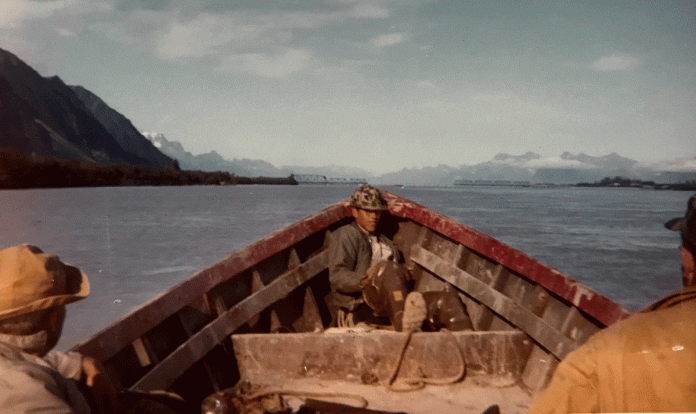
Hardly a day goes by that Cordovans don’t glance across Orca Inlet to view Hawkins Island. Snow will soon touch its rounded tops, a sure sign that winter is around the corner; and also a white signal for a flotilla of local hunters to begin pursuing a large population of blacktail deer scattered along its 22 miles length.
Most locals assume our island across the bay is named after E.C. Hawkins, the brilliant chief engineer who masterminded the construction of the Copper River and Northwestern Railway, which fostered the birth of Cordova as a port for shipping the metal from vast mines 196 miles away at Kennicott to Tacoma, Washington for smelting.

Photo courtesy of Anchorage Museum of History and Art
It’s a logical assumption. After all the two most prominent nearby mountains, Heney and Eccles, are named after key CR&NW Railway figures: Michael J. Heney, contractor and driving force behind its construction; and S.W. Eccles, President of the CR & NW Railway Company.
Yet in fact, in June of 1794, long before E.C. Hawkins was even born, Captain George Vancouver of the British Royal Navy named the island after an officer in his ship’s complement; with it first being examined by a party in a smaller boat piloted by James Johnstone, hence the name Johnstone Point on nearby Hinchenbrook Island.
What prompted this Hawkins research is a remarkable photo uncovered during a foray into the Shellhorn Archives, also known as The Attic. Taken in September of 1964, it shows Beaver Nelson of Seward huddled in the bow of a 22-foot work skiff heading up the Copper River toward the railway bridges that spanned the Copper at 27 Mile. Nelson, along with UAF college buddies Steve Leirer, David Watsjold, and Bob Simpler, had come down to Cordova for a duck hunt at our cabin at Pete Dahl. At that time, due to the 9-foot uplift from the earthquake in March of ’64, the only way we could access the cabin was to run down from 27 Mile.
What startled me most in the photo was the huge metal spans across the river in the background; seven of them in total. And even more surprising, after further research, including a great book titled Iron Rails to Alaskan Copper: The Epic Triumph of Erastus Corning Hawkins, by Alfred O. Quinn, was learning that the set of bridges was not in the original railway design.
The first right-of-way plan had the railway taking a left at 27 Mile and following the base of the mountains beyond Flag Point for 18 miles up along the west side of the Copper until reaching the lower edges of Childs Glacier. There a bridge would be built across the Copper (estimated cost: half a million dollars), and then further up, the famous Million Dollar Bridge (actual cost: $1,424,774) would be built back across the Copper between Childs and Miles Glacier.
Hawkins carefully examined the plan, noting it would require massive rock excavation plus snow sheds along almost the entire route to protect the railway from avalanches, and opted instead to use “islands” scattered across the river starting at 27 Mile as stepping stones for the lower river crossing.

Photo by Dick Shellhorn/The Cordova Times
This bold gamble was based on only one year of hydrology studies plus reports from earlier explorers, and the first bridge at 27 Mile was a wooden pile trestle which allowed work to continue on up toward 52 Mile while a bigger metal span bridge was completed.
Hawkin’s engineering tactics also anticipated ever-changing water flow throughout the entire route. The first 49 miles contained more than 100 wooden trestles, some of considerable length. When the railway was completed in 1911, there were 129 bridges in the first 131 miles. Replacing the wooden ones was much cheaper than building more permanent steel structures.
Hawkins would not have been among those who are surprised by recent changes in the Copper River that have wiped out the bridge at 36 Mile and are now eating away at the gravel highway at 45 Mile. Nor would bridges that now have no flow under them, such as at 8 Mile or 34 Mile, have been very noteworthy. For Hawkins mentioned prolonged freshets (sound familiar?), the breaking up of impounded glacial lakes, and unpredictable changes in river courses caused by unusual spring floods, to all be expected.
However, Quinn’s book did contain a surprise, near the very end, that may have pleased the quiet and modest engineer, who died at age 51 just a year after the railway was completed.
There is a mountain named after him, although it is certainly not visible to Cordovans. In 1930, USGS geologist Lawrence Martin named a 10,000-foot peak seven miles northwest of Mt. Tom White in his honor. Mt. Hawkins is located far up the Copper, and overlooks the Bremner River and rugged terrain through which E.C. Hawkins performed more of his daring engineering magic.
Yet if Cordovans want to consider the island right across the way to be named after him, why not?
For without Hawkins’ genius, there might not have been any such town.














